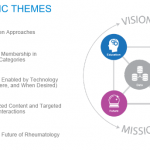 There was a time when medical textbooks were the ultimate resource for information in the field. The modern age of the U.S. medical textbook began in the 1920s and was fully established by the 1960s. Internal medicine saw the appearance of textbooks by Russell Cecil (1927) and Tinsley Harrison (1950), with specialty textbooks by Goodman and Gilman (pharmacology, 1941), Hollander/McCarty/Comroe (arthritis, 1940), Wintrobe (hematology, 1942) and Eugene Braunwald (cardiology), among others.
There was a time when medical textbooks were the ultimate resource for information in the field. The modern age of the U.S. medical textbook began in the 1920s and was fully established by the 1960s. Internal medicine saw the appearance of textbooks by Russell Cecil (1927) and Tinsley Harrison (1950), with specialty textbooks by Goodman and Gilman (pharmacology, 1941), Hollander/McCarty/Comroe (arthritis, 1940), Wintrobe (hematology, 1942) and Eugene Braunwald (cardiology), among others.
In 1960, Dr. Cecil wrote:
I think we must assume that textbooks are still essential to medical education …. The methods of teaching medicine will undoubtedly change as new ideas and new techniques on pedagogy are developed in university circles, but there will always be a need of authoritative treatises on every aspect and every field of medical knowledge.1
For many of us in rheumatology, the Kelley and McCarty arthritis volumes, which were updated every five years or so, were considered reliable repositories for the final say on rheumatoid arthritis, osteoarthritis and the like for interested readers. Specific disease topics were covered by monographs, which included Dubois’ textbook on lupus erythematosus.
However, a quiet change in the publishing field, has taken place over the past 20 years—one not being mentioned in any peer-reviewed publications. Since 2000, numerous medical textbook titles have disappeared, and readership has shifted to sources available on the internet, which includes services like UpToDate and which are frequently updated to highlight new information.
This trend is similar to what has occurred in the larger textbook publishing industry, which reported a peak in printed textbooks in 2015.2 Sales of traditional medical textbooks have been stable internationally, but have decreased in North America by over 50%, and they have become prohibitively expensive.
An explosion of ebooks that cover rheumatology topics has occurred, with only a few hundred copies actually printed. Some chapters of specific textbooks can now be downloaded without having to buy the whole book, along with slide sets for specific tables and figures. Although this is more convenient to the medical practitioner, the quality of information presented, and recommendations and nuances from those who have spent years in the field, has not kept up with the times.
At the same time, the traditional medical textbook has aged. Many current volumes are edited by the same group of people who have done so for about 30 years. This has tended to result in a relative lack of inclusivity and diversity of international authors, as well as young and promising investigators, as chapter authors or section editors, a problem recognized in journal editorial boards as well.3 These authors lack innovation in coming up with new chapter titles or formats. There is a lack of strategic planning, and many traditional textbooks are becoming stale.

